Summary of Findings
Barack Obama is seen by most Democrats as inspiring and as most likely to bring about change. Hillary Clinton is widely viewed as prepared to lead the country, but also hard to like. These are some of the major themes in campaign news coverage — identified by the Project for Excellence in Journalism (PEJ) — which are registering with the public.
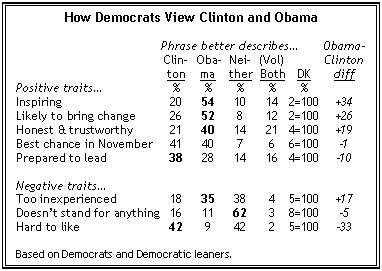
Obama has a clear advantage on three positive campaign themes. Fully 54% of Democrats and independents who lean Democratic say the word “inspiring” better describes Obama than Clinton, while 52% say the phrase “will bring change” applies more to the Illinois senator. By a wide margin (40%-21%), more Democrats also say that the phrase “honest and trustworthy” better describes Obama than Clinton.
Clinton holds a considerable advantage as the candidate more often viewed as “prepared to lead;” 38% of Democrats say this phrase better describes Clinton, while 28% say it applies to Obama. However, Clinton also is widely seen as “hard to like.” By more than four-to-one (42%-9%), more Democrats say this phrase better describes Clinton than Obama, while 42% say it applies to neither candidate. Obama also is associated with a negative trait: 35% say the phrase “too inexperienced for the job” better describes him than it does Clinton, while 38% say it describes neither candidate.
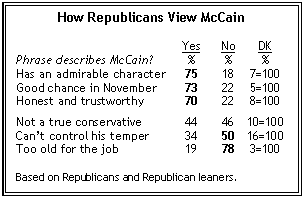
PEJ also identified several themes in the news coverage of John McCain, the frontrunner for the Republican nomination. Three-quarters of Republicans and independents who lean Republican say the phrase “has an admirable character” describes McCain, while about as many associate him with the phrases “has a good chance of getting elected in November” (73%), and “honest and trustworthy” (70%). McCain was not compared with any other GOP candidate in these dimensions; instead, Republican and Republican-leaning independents were asked whether the phrases applied to him.
However, another prominent story angle identified by PEJ — that McCain is not a strong conservative — also has resonated with Republicans. Republicans are evenly divided over whether the phrase “not a true conservative” describes McCain. Nearly half (46%) say this phrase does not describe McCain, but about as many (44%) say that it does.
About a third of Republicans (34%) say that the phrase “can’t control his temper” describes McCain, while 50% say it does not. Notably, relatively few Republicans (19%) say that the phrase “too old for the job” describes the 71-year-old McCain; fully 78% say it does not describe him.
Talk Radio’s Limited Reach
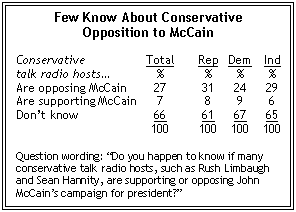
Barely a quarter of Americans (27%) are aware that many conservative talk radio hosts are opposing John McCain’s campaign for president. Another 7% mistakenly believe hosts like Rush Limbaugh and Sean Hannity support McCain’s candidacy.
Even among Republicans, awareness of the arguments against McCain is limited. Only 31% know about the opposition to McCain on talk radio. Even among Republicans who are following the campaign “very closely” only 42% know that these hosts disapprove of McCain.
These findings are based on the most recent installment of the weekly News Interest Index, an ongoing project of the Pew Research Center for the People & the Press. The index, building on the Center’s longstanding research into public attentiveness to major news stories, examines news interest as it relates to the news media’s agenda. The weekly survey is conducted in conjunction with The Project for Excellence in Journalism’s News Coverage Index, which monitors the news reported by major newspaper, television, radio and online news outlets on an ongoing basis. In the most recent week, data relating to news coverage was collected from Feb. 4-10 and survey data measuring public interest in the top news stories of the week was collected Feb. 8-11 from a nationally representative sample of 1,007 adults.
Campaign News Interest for Super Tuesday Week
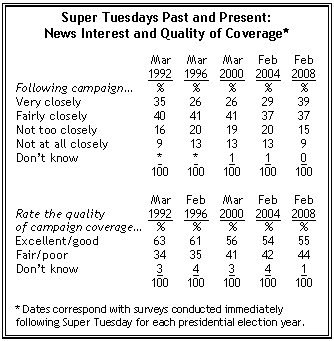
Public interest in news about the presidential campaign reached a new high during the week of Super Tuesday when voting took place in more than 20 states nationwide. Four-in-ten Americans (39%) followed news about candidates for the 2008 presidential election very closely, while 45% say they followed election news more closely than any other story last week.
Coverage of the campaign dominated the news cycle reaching its high point for the year at 55% of the weekly newshole. These high numbers for coverage and interest rival last year’s most covered news story, the Virginia Tech shootings. More than half the national newshole was devoted to the shootings the week of April 16, and 56% of the public followed the story more closely than any other.
Public interest in news about the presidential campaign this past week was higher than in comparable time periods during the last several election cycles. Fewer than three-in-ten followed campaign news very closely following Super Tuesdays in 1996, 2000 and 2004. Public interest in the 1992 Super Tuesday campaign was comparable to interest in this year’s contest (35% followed very closely in March of 1992 and 39% today).
A small majority of the public gives news organizations high marks for their coverage of the presidential campaign: 55% of the public says that the press is doing an excellent (11%) or good (44%) job covering the race. These numbers are comparable to the grades the press received in 2004 and 2000 but down somewhat from 1996 and 1992.
Candidate Visibility Favors Democrats, Despite Balanced Campaign Coverage

As has been the case throughout the 2008 presidential campaign, Democrats Clinton and Obama remain by far the most visible presidential candidates. Currently, 38% of Americans say that Obama is the candidate they have been hearing the most about in the news lately, while 31% name Clinton. By comparison, just 13% say that they have been hearing the most about Republican John McCain (up from 5%, Jan 18-21). Far fewer people named Republican presidential hopefuls Mike Huckabee (2%) and Ron Paul (1%) or Mitt Romney (2%) who suspended his campaign last week.
The national news coverage of the campaign last week focused primarily on Clinton, Obama and McCain; however, it did not favor any one candidate significantly, nor did it favor the Democratic candidates more than McCain, as public perceptions might suggest. According to PEJ’s weekly Campaign Coverage Index, John McCain was featured as a significant or dominant newsmaker in 42% of campaign stories last week; 41% featured Clinton and 40% featured Obama.
Who Followed Super Tuesday Coverage
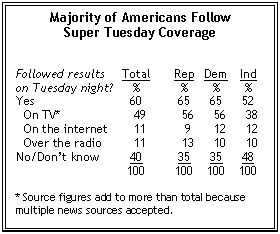
A majority of the public (60%) followed the election returns Tuesday night as the results of Super Tuesday voting and caucusing poured in from around the country. Far fewer Americans followed news coverage of the Iowa Caucuses (30%) and the New Hampshire primaries (38%) on the evenings of those contests. Roughly half of Americans (49%) followed Super Tuesday results on TV, making it the dominant source for election night coverage, while 11% each followed the returns on the internet or on radio. Republicans and Democrats were equally likely to have followed the coverage live, with 56% of both groups following results on TV. Roughly one-in-ten Republicans went to the the radio (13%) or the internet (9%) for primary results and comparable numbers of Democrats looked to these sources (12% on the internet and 10% on radio).
Republicans not Pleased with Nominating Process
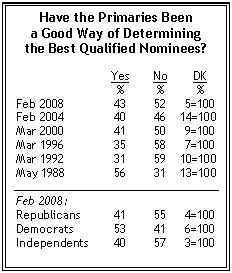
Overall, 43% of Americans say that the presidential primaries so far have been a good way of determining who the best qualified nominees are, while a slim 52% majority says they are not the best way. The balance of opinion is largely unchanged from comparable points in the 2004 and 2000 primary seasons. In both 1996 and 1992 even fewer felt the primaries were working well, while nearly six-in-ten felt that they were not. Approval of the primary process was much more widespread in May, 1988, when 56% said they were working to determine the best qualified nominees.
Most Democrats are upbeat about the effectiveness of the primary process, while most Republicans and independents disagree. Among Democrats, 53% say the primaries pick the best candidates, while 41% disagree. Among Republicans 41% say the primaries are selecting the most qualified candidates, while 55% say they are not.
Tornadoes, Iraq and Stimulus Plan
In other news last week, a quarter of Americans followed news about the tornadoes and violent storms that swept through the South and Midwest; 17% listed this as their most closely followed news story. The national news media devoted 7% of its coverage to this story.

While 24% of the public followed news about the current situation and events in Iraq very closely, Iraq was largely absent from the national media’s agenda, filling a meager 1% of the newshole. Fewer than one-in-ten Americans cited Iraq as the story they followed most closely.
The public paid modest attention to the news that President Bush and Congress had agreed on an economic stimulus plan. About one-in-five (22%) followed news about the stimulus package very closely and 8% listed it as their top story.
Microsoft’s bid to buy internet giant Yahoo garnered little national news coverage (1%) or interest (10% followed very closely and 1% listed this as their most closely followed story). There was a substantial gender gap in interest with men (15%) more than twice as likely as women (7%) to have followed the story very closely. Fully 50% of women say they didn’t follow the story at all.
About the News Interest Index
The News Interest Index is a weekly survey conducted by the Pew Research Center for the People & the Press aimed at gauging the public’s interest in and reaction to major news events.
This project has been undertaken in conjunction with the Project for Excellence in Journalism’s News Coverage Index, an ongoing content analysis of the news. The News Coverage Index catalogues the news from top news organizations across five major sectors of the media: newspapers, network television, cable television, radio and the internet. Each week (from Sunday through Friday) PEJ will compile this data to identify the top stories for the week. The News Interest Index survey will collect data from Friday through Monday to gauge public interest in the most covered stories of the week.
Results for the weekly surveys are based on telephone interviews among a nationwide sample of approximately 1,000 adults, 18 years of age or older, conducted under the direction of ORC (Opinion Research Corporation). For results based on the total sample, one can say with 95% confidence that the error attributable to sampling is plus or minus 3.5 percentage points.
In addition to sampling error, one should bear in mind that question wording and practical difficulties in conducting surveys can introduce error or bias into the findings of opinion polls, and that results based on subgroups will have larger margins of error.
For more information about the Project for Excellence in Journalism’s News Coverage Index, go to www.pewresearch.org/journalism.


